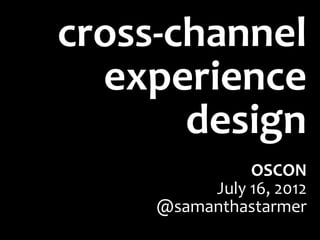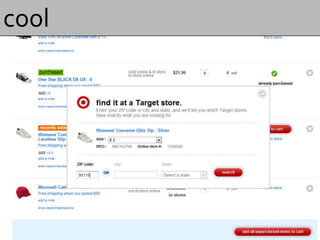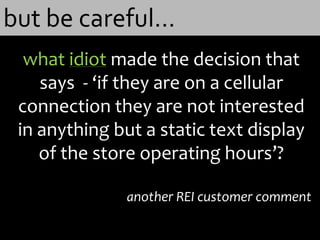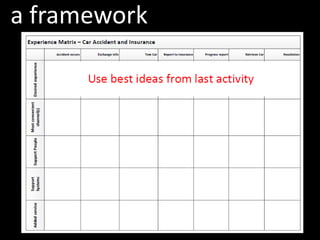How to Design for the Future - Cross Channel Experience Design
- 1. how to design for the future
- 3. cross-channel experience design OSCON July 16, 2012 @samanthastarmer
- 4. today what is cross channel design? why care about cross channel design how to think about cross channel design try cross channel design start cross-channel design now
- 6. extrapolation encouraged http://www.flickr.com/photos/danilush/3259099985
- 7. questions & input encouraged http://www.flickr.com/photos/ducdigital/3011652637/
- 8. three activities http://www.flickr.com/photos/acplinfo/3721979202/
- 9. scheduled break http://www.flickr.com/photos/johnmcnab/4298812
- 10. but anytime… http://www.flickr.com/photos/baggis/4701908515
- 11. Director, Customer Experience for REI Experience Design Information and Content Management Program Management Microsoft, Amazon Teach at University of Washington
- 13. who are you? Support Engineer Programmer Systems Analyst CIO Web Application Web Manager Developer System Architect Technical Analyst Software Engineer Lead Senior Software Engineer IT Director/Engineering User Experience Engineer
- 14. what do you hope to learn? tools that can help me improve the online experience of the product to educate people about the actual physical product. a primer for cross-channel experience design, an overview, and maybe some high points expanded upon. Why and How to design cross channel experience design How to think about things more broadly to encompass the entire user experience. what is cross-channel experience design?
- 15. a story… http://www.flickr.com/photos/sugarpond/3016905349
- 16. july 19, 6am
- 17. it started as a good day
- 18. and then…
- 19. kaboom http://www.flickr.com/photos/amishpatel/4803420473
- 20. my car
- 21. his car
- 22. and yes…
- 23. the cop car http://www.flickr.com/photos/sillygwailo/56
- 24. proof of insurance http://www.flickr.com/photos/rootology/2767323250/
- 25. oh crap
- 26. just don’t do it again http://www.flickr.com/photos/rootology/2767323250/
- 28. need to get car out of road
- 29. so sad – collision repair http://www.carstar.com/files/6uiyw73inwb3f999189vjwzsyjpv7o09.jpg
- 30. this is why I have insurance
- 32. two hours later – ow.
- 33. good, they have an app
- 34. can’t get in
- 35. okay, trying the website
- 36. arrrrgh
- 37. damn, have to talk to a human
- 38. “go to Valley Medical Center”
- 39. we can’t help you
- 40. “oops”
- 41. THIS Valley Medical Center http://cdn.assets.sites.launchrocketship.com/7a019f65-a5c3-4d32-930 0640affd6f7b/files/de97003a-2719-4f24-bf02-3771bcfd0a72/zvm-east_exterior-afternoo
- 42. five days later…
- 45. my friend, the fax machine
- 46. a flurry of mail
- 47. from all different people
- 48. confusing mail
- 50. over three months later
- 51. insurance was supposed to pay this…
- 52. we can’t help
- 53. crap, i better pay
- 54. silence silence
- 56. six months later
- 57. more silence
- 58. march
- 59. thanks a bunch. Ta
- 63. the future of web design isn’t just the web
- 64. we live our lives beyond websites physical experiences, apps, phone, etc…
- 65. we need to design beyond websites
- 66. design for cross channel experiences
- 68. idly flipping – oh, cheap TV
- 69. can I buy it locally?
- 70. gotta buy something for me
- 71. cool
- 72. all set
- 73. here we are
- 74. picking up in store…
- 76. but I have my list!
- 77. and it tells me where!
- 78. a little hard to see…
- 79. but it worked!
- 80. technology is ubiquitous http://www.nytimes.com/imagepages/2011/12/22/garden/22SKYPE1.html
- 83. digital and physical are colliding
- 85. 70% of US online consumers research products online and purchase them offline Forrester, Profiling The Multichannel Consumer, July 2009
- 86. 53% of mobile searches on Bing have a local intent Greg Sterling Search Engine Land https://searchengineland.com/microsoft-53-percent-of-mobile-searches-have-local-intent-55556
- 88. (and here is our opportunity)
- 89. integrated experiences are few and far between Alexandra Deschamps-Sonsino http://www.slideshare.net/designswarm/creating-the-internet-of-things
- 90. entire industries are in their customer experience infancy (…health insurance, TV service, Internet Service providers, PC manufacturers, wireless service providers, airlines and credit card providers.) 2011, Forrester Research, Inc.
- 91. we usually design for a particular channel
- 92. users don’t distinguish channels
- 94. users don’t think about design disciplines
- 95. http://www.kickerstudio.com/blog/images/ux.jpg http://www.jjg.net/elements/pdf/elements.pdf http://www.montparnas.com/articles/wp- content/uploads/2006/10/user%20experience%20design%20explained.gif http://mickwinters.com/wp-content/uploads/2010/02/venn1.gif
- 96. users do think about all of their experiences
- 97. across time, touchpoints, devices and channels
- 98. wherever they see your brand
- 99. advertising
- 100. packaging http://thewordzombie.com/wp-content/uploads/clamshell-packaging.jpg
- 101. employees http://www.flickr.com/photos/7577938@N02/4897443265
- 102. a truck http://www.flickr.com/photos/walmartcorporate/5261659794
- 103. a sign http://www.flickr.com/photos/mrvelocipede/523744336
- 104. all touchpoints impact user experience
- 105. shh…organizational underpants http://www.flickr.com/photos/practicalowl/1423935574
- 106. remember…
- 107. ad: “volkl rtm 84/ipt wide ride”
- 108. let’s look on the site
- 109. search volkl rtm 84 - nada
- 110. search volkl wide ride - nope
- 111. whoops
- 112. people notice This experience has been so stupid. There is no way to explain the huge gap between operations in the store and online. I will never be shopping at either again. I do not understand how you can want and advertise 100% customer satisfaction when I know I am 0% satisfied. REI customer comment
- 113. experiences are across touchpoints, channels, mediums & devices
- 114. we have to design beyond websites, mobile devices, software apps…
- 116. not easy
- 117. cross between herding cats http://www.flickr.com/photos/wendyness/2278274546
- 118. and slaying dragons http://www.flickr.com/photos/76578669@N00/377000490
- 119. 5 principles 1. consistent 2. convenient 3. connected 4. contextual 5. (a) cross time
- 120. consistent
- 121. shopping has many stages
- 122. especially gifts
- 123. awesome, gift ideas
- 124. we often cross channels
- 125. and need consistency
- 126. good, the same recommendations
- 127. here too
- 128. not so good
- 129. same item, different info sign catalog site
- 130. and more different info eMail site in-store product handout product tag advertising
- 131. convenient
- 132. my first iPhone app
- 133. even better…
- 134. no need to call http://www.flickr.com/photos/zachklein/3964249 http://www.flickr.com/photos/jsrcyclist/31813
- 135. or get out of the car Walgreen’s drive in http://www.flickr.com/photos/ambernectar/4042608385
- 136. not so convenient
- 137. what happened to self service?
- 138. connected
- 139. the experience of transitions http://www.flickr.com/photos/mcdemoura/2209204939
- 140. different tastes Netflix
- 141. on the iPad
- 142. on the iPhone
- 143. not so good
- 144. my mom
- 145. her favorite store
- 146. directory
- 147. departments
- 149. but…
- 150. no encore
- 151. but they have plus sized clothes
- 152. lots of them
- 153. and they are tagged encore
- 154. mom was sad
- 155. contextual
- 156. may not have a tape measure http://www.flickr.com/photos/nicpic/30423961
- 157. but I have my phone!
- 158. street bump residents use Street Bump to record “bumps” which are identified using the device’s accelerometer and located using its GPS http://www.flickr.com/photos/topsy/188144452 http://www.newurbanmechanics.org
- 159. which context makes sense? Not sure how to cancel a class I registered for online. The cancellation policy just says what time frame I need to cancel in, but not how to do it online. Only suggestion is to call the store. Doesn't seem worth the hassle. REI customer comment
- 160. but be careful… what idiot made the decision that says - ‘if they are on a cellular connection they are not interested in anything but a static text display of the store operating hours’? another REI customer comment
- 161. (a)cross time
- 162. traveling on 3/26/11
- 163. yuck
- 164. nightmare lines
- 165. they didn’t forget about me
- 166. not so good
- 167. tests at the doctor’s office
- 168. results by mail
- 169. but not on the website?
- 170. 5 principles 1. consistent 2. convenient 3. connected 4. contextual 5. (a) cross time
- 171. 5 methods 1. think in terms of services 2. share the sandbox 3. start walking 4. comfort in discomfort 5. why vs. what
- 172. 1. Think in terms of services think in terms of services Waitress
- 173. oooh, shoes
- 174. cute shoes Fluevog on iPad
- 175. save on shipping? From: seattlefluevog@cablespeed.com To: sstarmerj@hotmail.com Subject: Fluevog order 20110211-00072873 Date: Fri, 11 Feb 2011 16:52:38 -0800 Hey Samantha, We have both shoes you ordered online here at the Seattle store. If you’d like to pick them up this weekend and save on shipping let us know otherwise they will ship out Monday. Thanks, Leah John Fluevog Shoes 205 Pine St. Seattle, WA 98101 phone: (206)441-1065 fax : (206)728-7955 seattle@fluevog.com www.fluevog.com www.myspace.com/fluevogseattle "There are two kinds of people: those who shy away from attention, and those who wear Fluevogs." - JF
- 176. visit the store? don’t mind if I do http://www.flickr.com/photos/trufflepig/4370405501
- 177. Incremental Sale
- 178. 2. share the sandbox http://www.flickr.com/photos/erikwdavis/2687670846
- 179. let others in
- 180. let others design
- 181. let others play with you UX Mag
- 182. 3. start walking http://www.flickr.com/photos/jonathanbeard/3038114579/
- 183. get out of your cube
- 184. go to another department
- 185. 4. comfort in discomfort
- 186. you don’t have to be an expert
- 187. from one of my employees “an interesting thing happened today – we were invited to help Visual Merch decide what shelf labels to use in the retail stores .”
- 188. eek – I don’t know store design http://www.twobackpackers.com/wp-content/uploads/2009/07/REI-Backpacks.jpg
- 189. my employee was smarter “an interesting thing happened today – we were invited to help Visual Merch decide what shelf labels to use in the retail stores .” “This is a great win for us”
- 190. 5. why vs. what http://www.flickr.com/photos/segozyme/3105128025/
- 191. buying a tent
- 192. for backyard camping? http://www.flickr.com/photos/jcast911/4037694806
- 193. or backcountry snow? http://www.flickr.com/photos/reway2007/427303733
- 195. ACTIVITY make it or break it
- 196. remember?
- 197. my car
- 198. ow
- 199. the paperwork
- 200. Insurance – a Cross Channel Story
- 201. what are the make or break experience opportunities?
- 202. think about my as-is experience – what actually happened? Be clear on the narrative what were my emotions? where was my experience broken? (sad face) where could Ameriprise have ‘made’ my experience? (happy face) write down the make or break opportunities
- 204. observations?
- 206. designing for the future
- 207. (some) tools stakeholder co-design interviews body storming field research business origami touchpoint matrix service blueprint service inventory experience map design games experience matrix
- 208. tips do early in project – ideally well before requirements or user stories focus on ideation and brainstorming – not building, architecting or designing can be used within waterfall or agile methodologies or anything in between best to do in cross divisional groups
- 209. good ideas here
- 210. stakeholder interviews http://www.flickr.com/photos/kino-eye/226951415
- 211. stakeholder interviews what experiences do internal stakeholders think should happen? what experiences do stakeholders think ARE happening? what assumptions are stakeholders making?
- 212. field research http://www.flickr.com/photos/romeral/3911756000
- 213. field research what experiences are happening? what experiences are customers expecting? what channels, devices or platforms do customers want to interact with? When? what do customers do if their expectations are disappointed?
- 214. touchpoint matrix http://brandtouchpointmatrix.com/
- 215. touchpoint matrix track all ways customers interact with your organization can use both for as-is and to-be states excellent for corralling complex, multi- channel programs and products great to use for mapping out needed system architectures helpful for non-web/non-technology people to understand impacts
- 216. design games http://www.flickr.com/photos/elitatt/4959931 232 http://www.flickr.com/photos/centralasian/4099680559
- 217. design games great with non-designers bar is low, nothing is wrong think of as more play than work can bring out quieter types new ways of thinking Low tech methods create level playing field for multi-disciplinary participants
- 218. gamestorming - the book http://www.flickr.com/photos/elitatt/4959938630
- 219. co-design http://www.flickr.com/photos/thinkpublic/4499674785
- 220. co-design sketch with project team draw with stakeholders diagram with support teams sticky note with customers less about the outcome, more about the conversation Can also call it co-creation, brainstorming, etc (the word ‘design may scare some people)
- 222. body storming http://www.flickr.com/photos/xian/3763798434
- 223. body storming sketching not with a pencil and paper, but with our bodies (Dave Gray) physically act out possible experiences often used for designing services, especially within physical environment start with scenario or task, improv the customer and support roles (including props)
- 224. business origami (@jessmcmullin) http://www.flickr.com/photos/benry/4101687804
- 225. business origami 3 dimensions helps envision experience solutions can be easier than sketching for non- designers to feel creative great for services and experiences that involve crossing locations easy to move pieces lessen any feeling of commitment or making a mistake
- 226. service inventory http://farm5.static.flickr.com/4023/4526736556_3b5a628b7f.jpg
- 227. service inventory inventory all services customer encounters similar to a process map but focuses on the customer and their service needs good to build after mapping customer’s journey illuminates areas where you can surprise & delight (or royally screw up)
- 228. experience map http://www.businessweek.com/innovate/content/nov2008/id20081110_531328.htm
- 229. experience map customer perspective, actions and reactions throughout interactions triggers and touchpoints intangible and qualitative motivations, frustrations and meanings can get all points of view on the table (e.g. is your experience my experience?)
- 230. many different ways to map
- 235. ACTIVITY experience map
- 236. please make it better!!
- 237. you are ameriprise Ta
- 238. accident – the basic sequence 1. accident occurs 2. exchange information 3. tow car 4. report to insurance 5. progress report 6. retrieve car 7. resolution
- 239. what would have made my experience better?
- 240. think about the accident journey the main steps from the customer’s perspective that need to occur in resolving an accident claim what is the desired experience? what would give me a happy face in each section? map out the desired experience – write down the optimal ways to support the holistic, cross channel experience
- 241. a framework
- 242. service blueprint
- 243. service blueprint start with the customer experience track the customer actions include needed touchpoints determine how service components link determine how internal people, processes and systems support
- 244. Service Blueprint http://lovelearn.wordpress.com/2009/07/11/initial-blueprint/
- 245. SCAD Service Design Project http://servd.us/The_Project_files/Screen%20shot%202010-02-03%20at%2011.38.26%20PM.png
- 246. ACTIVITY experience matrix
- 247. what is needed to support the better experience?
- 248. think about use desired experience from last activity most convenient channel/touchpoint for each part of the experience(face to face, mobile app, phone, website, etc) how the experience components need to link together for a holistic cross-channel experience the support people and systems needed EXTRA CREDIT – extra services or benefits to ‘surprise and delight’
- 249. a framework
- 250. observations?
- 251. how to
- 253. 5 ways to start 1. document the present 2. map the future 3. get behind the scenes 4. cross train 5. share the wealth
- 254. 1. document the present
- 255. not just for fun
- 256. can be notes, sketches http://www.flickr.com/photos/frerieke/3882000183
- 257. or photos
- 259. 2. map the future http://images.asc.ohio-state.edu/is/image/eHistory/world/images/maps2/1942world1600.jpg
- 260. getting from point A to point B; and everything in between
- 261. think about the customer’s whole journey
- 262. 3. get behind the scenes http://www.flickr.com/photos/honorapearls/4155009907/
- 263. are experiences supported? http://www.flickr.com/photos/vitorcastillo/2994723741
- 264. here?
- 265. here? http://www.flickr.com/photos/mattwright/1787856/
- 266. and here? http://www.flickr.com/photos/oldonliner/3484504583/
- 269. 4. cross train http://www.flickr.com/photos/zackojones/4191554608/
- 270. it’s amazing what you learn
- 271. 5. share the wealth http://www.flickr.com/photos/jimfrazier/1810966604/
- 272. everyone owns cross channel experience
- 273. thank you!! http://www.flickr.com/photos/baking_in_pearls/3960662314
- 274. questions?? samantha starmer @samanthastarmer sstarme@rei.com http://www.flickr.com/photos/druclimb/3277540656/
Editor's Notes
- #6: Door picture
- #10: Door picture
- #13: Door picture
- #61: Door picture
- #67: Door picture
- #193: Buying a tentWhy?
- #194: Buying a tentWhy?
- #203: Door picture
- #206: Door picture
- #239: Door picture
- #241: Door picture
- #244: Door picture
- #249: Door picture
- #264: Buying a tentWhy?
- #266: Buying a tentWhy?
- #267: Buying a tentWhy?
- #270: Buying a tentWhy?


















































































































































































































































































